Chapter_15 The Demand for Money多恩布什宏观经济学(教学课件)PPT
宏观经济学课件O.BlanchardMacro-economics6thchapter15
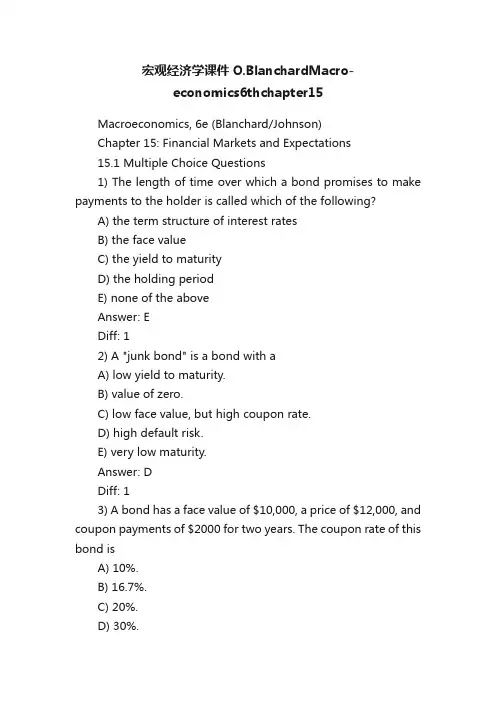
宏观经济学课件O.BlanchardMacro-economics6thchapter15Macroeconomics, 6e (Blanchard/Johnson)Chapter 15: Financial Markets and Expectations15.1 Multiple Choice Questions1) The length of time over which a bond promises to make payments to the holder is called which of the following?A) the term structure of interest ratesB) the face valueC) the yield to maturityD) the holding periodE) none of the aboveAnswer: EDiff: 12) A "junk bond" is a bond with aA) low yield to maturity.B) value of zero.C) low face value, but high coupon rate.D) high default risk.E) very low maturity.Answer: DDiff: 13) A bond has a face value of $10,000, a price of $12,000, and coupon payments of $2000 for two years. The coupon rate of this bond isA) 10%.B) 16.7%.C) 20%.D) 30%.E) none of the aboveAnswer: CDiff: 14) A discount bond is a bondA) with no coupon payments.B) where the price of the bond is greater than its face value.C) where the interest rate is zero.D) where the face value is zero.E) that never matures.Answer: ADiff: 15) For this question, assume that one-year and two-year bonds have the same risk; therefore, you can ignore risk here. Assuming that there is arbitrage between one-year bonds and two-year bonds, we know that the expected rate of return on two-year bondsA) will equal the expected rate of return from holding a one-year bond for one year.B) will equal the expected rate of return from holding a one-year bond for two years.C) will be larger than the expected rate of return from holding a one-year bond for one year.D) will be smaller than the expected rate of return from holding a one-year bond for one year.E) will be exactly half the rate of return on one-year bonds.Answer: ADiff: 26) A bond has a face value of $1,000, a price of $1,200, and coupon payments of $100 for two years. The "current yield" of this bond isA) 8.33%.B) 10%.C) 12%.D) 83%.E) none of the aboveAnswer: ADiff: 27) An upward-sloping yield curve suggests that financial market participants expect short-term interest rates willA) rise in the future.B) fall in the future.C) be unstable in the future.D) not change in the future.E) be equal to zero in the future.Answer: ADiff: 28) Suppose financial market participants expect short-term rates in the future to be less than current short-term interest rates. Given this information, we would expectA) an upward sloping yield curve.B) a downward sloping yield curve.C) an upward shifting yield curve.D) a downward shifting yield curve.E) a horizontal yield curve.Answer: BDiff: 29) Assume that the current one-year rate is 5% and the two-year rate is 7%. Given this information, the one-year rate expected one year from now isA) 5%.B) 6%C) 7%D) 9%E) 12%Answer: DDiff: 210) Suppose the current one-year interest rate is 4%, and financial markets expect the one-year interest rate next year to be 8%. Given this information, the yield to maturity on a two-year bond will be approximatelyA) 4%.B) 6%.C) 8%.D) 12%.E) none of the aboveAnswer: BDiff: 211) Suppose the current one-year interest rate is 4%. Also assume that financial markets expect the one-year interest rate next year to be 5%, and expect the one-year rate to be 6% the year after that. Given this information, the yield to maturity on a three-year bond will be approximatelyA) 4%.B) 5%.C) 6%.D) 15%.Answer: BDiff: 212) Which of the following bonds (of equal maturity) would have the largest risk premium?A) U.S. government bondsB) German government bondsC) the bonds of a financially stable corporation, like IBMD) Bondsbrated Aaa by Moody'sE) junk bondsAnswer: EDiff: 113) Suppose there is a decrease in the short-term interest rate. Give this reduction in the current short-term interest rate, which of the following will most likely occur?A) the long-term interest rate will increase.B) the long-term interest rate will remain the same.C) the long-term interest rate will decrease by more than the short-term rate.D) the long-term interest rate will decrease by the same amount as the short-term rate.E) the long-term interest rate will decrease, but by less than the short-term rate.Answer: EDiff: 214) Which of the following statements about indexed bonds is correct?A) they were relatively recently introduced in the United States.B) they exist in England.C) they have a nominal interest rate that rises when the inflation rate rises.D) all of the aboveE) none of the aboveAnswer: D15) Which of the following best explains why the long-term interest rate will generally change by less than 1% when the short-term interest rate changes by 1%?A) the mathematical calculations are more difficult for analysts in the case of long-term bonds.B) long-term rates are always lower than short-term rates, so there is less room for them to change.C) financial market participants will not expect this increase in the short-term interest rate to persist fully in the future.D) financial markets are often affected by bubbles and fads.E) none of the aboveAnswer: CDiff: 216) Equity finance is represented by which of the following?A) when a firm borrows money from banksB) when a firm sells bondsC) when a firm sells shares of stockD) when a firm draws down retained earningsE) when a firm sells off part of its capital stockAnswer: CDiff: 117) Among the following, which is the broadest measure of stock prices in the United States?A) Dow Jones IndexB) FT indexC) Nikkei IndexD) Term Structure IndexE) Standard and Poor's 500 Composite IndexAnswer: E18) The fundamental value of a share of stock is equal to which of the following?A) the sum of expected dividendsB) the present value of expected dividendsC) the sum of coupon paymentsD) the present value of coupon paymentsE) the present value of the expected yieldAnswer: BDiff: 119) A share of stock will pay a dividend of $25 in one year, and will be sold for an expected price of $500 at that time. If the current one-year interest rate is 5%, the current price of the stock will be approximately equal toA) $100.B) $475.C) $500.D) $525.E) none of the aboveAnswer: CDiff: 220) For this question, assume that there is perfect arbitrage in the stock market. Given this assumption, economists believe thatA) movements in stock prices can be easily predicted.B) movements in stock prices are largely unpredictable.C) most stocks will diverge from their fundamental value.D) stocks will generally earn a lower rate of return than bonds.E) the rate of return on stocks will be equal to the rate of return on bonds.Diff: 221) Suppose the central bank implements a monetary contraction that is fully expected by financial market participants. Given this information, we would expectA) stock prices to rise.B) stock prices to fall.C) stock prices to remain unchanged.D) an ambiguous effect on stock prices.E) stock prices to fall and the interest rate to rise.Answer: CDiff: 222) Suppose the central bank implements a monetary expansion that is NOT fully anticipated by financial markets. Given this information, we would expectA) stock prices to rise.B) stock prices to fall.C) stock prices to remain unchanged.D) an ambiguous effect on stock prices.E) none of the aboveAnswer: ADiff: 223) Suppose policy makers implement a fiscal expansion that is NOT fully anticipated by financial market participants. We know that this willA) always cause stock prices to fall.B) always cause stock prices to rise.C) tend to cause stock prices to rise if the LM curve is very flat.D) tend to cause stock prices to rise if the LM curve is vertical.Diff: 224) Suppose policy makers implement an unexpected fiscal expansion. Further assume that monetary policy is expected to keep interest rates constant in response to this unexpected fiscal expansion. Given this information, we would expect thatA) stock prices will rise.B) stock prices will remain constant.C) this policy will have an ambiguous effect on stock prices.D) the effect on stock prices will depend on the slope of the IS curve.Answer: ADiff: 225) Which of the following represents a stock's fundamental value?A) the price the stock would sell at in the midst of a rational bubbleB) the price the stock would sell at if the interest rate were zeroC) the present value of its expected future dividend paymentsD) the simple sum of its future dividend paymentsE) none of the aboveAnswer: CDiff: 126) Which of the following represents the ratio of coupon payments to the face value of a bond?A) the interest rateB) the discount rateC) the coupon rateD) the risk premiumE) the current yieldAnswer: CDiff: 127) Suppose a bond promises to make a single payment at maturity. These types of bond are calledA) junk bonds.B) indexed bonds.C) corporate bonds.D) discount bonds.E) constant maturity bonds.Answer: DDiff: 128) Which of the following does NOT represent a form of debt finance?A) bondsB) loansC) stockD) all of the aboveAnswer: CDiff: 129) Which of the following represents a form of equity finance?A) stockB) loansC) bondsD) all of the aboveE) none of the aboveAnswer: ADiff: 130) Which of the following variables would NOT influence the ex-dividend price of a share of stock at time t?A) i1e t+1B) i1tC) $D e t+1D) none of the aboveAnswer: DDiff: 131) An expected reduction in the money supply will tend to causeA) an increase in stock prices.B) a reduction in stock prices.C) no change in stock prices.D) an ambiguous effect on stock prices.Answer: CDiff: 232) An expected increase in the money supply will tend to causeA) an increase in stock prices.B) a reduction in stock prices.C) no change in stock prices.D) an ambiguous effect on stock prices.Answer: CDiff: 233) An expected tax cut will tend to causeA) an increase in stock prices.B) a reduction in stock prices.C) no change in stock prices.D) an ambiguous effect on stock prices.Answer: CDiff: 234) An expected tax increase will tend to causeA) an increase in stock prices.B) a reduction in stock prices.C) no change in stock prices.D) an ambiguous effect on stock prices.Answer: CDiff: 235) An unexpected reduction in the money supply will tend to causeA) an increase in stock prices.B) a reduction in stock prices.C) no change in stock prices.D) an ambiguous effect on stock prices.Answer: BDiff: 236) An unexpected increase in the money supply will tend to causeA) an increase in stock prices.B) a reduction in stock prices.C) no change in stock prices.D) an ambiguous effect on stock prices.Answer: ADiff: 237) Suppose households unexpectedly increase consumption. Which of the following will occur as a result of this unexpected increase in consumption?A) an increase in stock pricesB) a reduction in stock pricesC) no change in stock pricesD) an ambiguous effect on stock pricesAnswer: DDiff: 238) Suppose households unexpectedly decrease consumption. Which of the following will occur as a result of this unexpected reduction in consumption?A) an increase in stock pricesB) a reduction in stock pricesC) no change in stock pricesD) an ambiguous effect on stock pricesAnswer: DDiff: 239) Suppose there are two types of bonds (one-year bonds and two-year bonds) and that the yield curve is initially upward sloping in period t. Note: For this question assume that: (1) expected inflation is zero; and (2) the relevant interest rate on the vertical axis of the IS-LM model is the one-year interest rate. Based on our understanding of the IS-LM model, of the yield curve and of financial markets, we know with certainty that an announcement in period t of a partially unexpected future increase in taxes (to be implemented in period t+1) will have which of the following effects?A) stock prices will increase in period tB) stock prices will fall in period tC) the yield curve will become steeper in period tD) none of the aboveAnswer: DDiff: 240) Assume that the one-year interest rate is on the vertical axis of the IS-LM model and that the yield curve is initially upwardsloping. Suppose that financial market participants expect that the central bank will pursue a monetary contraction in the future. Given this information, we would expect which of the following to occur?A) the yield curve will become steeperB) the yield curve will become flatterC) the yield curve will become horizontalD) the yield curve will become downward slopingAnswer: ADiff: 241) Suppose that financial market participants expect that the central bank will pursue a monetary expansion in the future. Also assume that the yield curve is initially upward sloping. Given this information, we would expect which of the following to occur?A) the yield curve will become steeperB) i2t will increaseC) i2t will decreaseD) the yield curve will become downward slopingAnswer: CDiff: 242) Suppose that financial market participants now expect a future tax increase in one year. Also assume that the yield curve is initially upward sloping. Given this information, we would expect which of the following to occur?A) the yield curve will become steeperB) i2t will increaseC) i2t will decreaseD) the yield curve will become downward slopingAnswer: CDiff: 243) Suppose that financial market participants now expect a future tax cut and that the yield curve is initially upward sloping. Given this information, we would expect which of the following to occur?A) the yield curve will become steeperB) the yield curve will become flatterC) the yield curve will become horizontalD) the yield curve will become downward slopingAnswer: ADiff: 244) For this question, assume that the Fed is expected to respond to any event by keeping the interest rate constant (i.e., equal to its initial level). An unexpected tax increase will causeA) stock prices to fall.B) stock prices to rise.C) no change in stock prices.D) an ambiguous effect on stock prices.Answer: ADiff: 245) For this question, assume that the Fed is expected to respond to any event by keeping the interest rate constant (i.e., equal to its initial level). An unexpected tax cut will causeA) stock prices to fall.B) stock prices to rise.C) no change in stock prices.D) an ambiguous effect on stock prices.Answer: BDiff: 246) Suppose the yield curve is initially horizontal. Suppose the current one-year interest rate increases by 4% while theexpected future one-year interest rate does not change. Which of the following will tend to occur?A) i2t will increase by 4%B) i2t will increase by 2%C) i2t will increase by less than 2%D) i2t will decrease by 2%Answer: BDiff: 247) For this question, assume that the Fed is expected to respond to any event by keeping output constant (i.e., equal to its initial level). An unexpected increase in taxes will causeA) stock prices to fall.B) stock prices to rise.C) no change in stock prices.D) an ambiguous effect on stock prices.Answer: BDiff: 248) For this question, assume that the Fed is expected to respond to any event by keeping output constant (i.e., equal to its initial level). An unexpected increase in government spending will causeA) stock prices to fall.B) stock prices to rise.C) no change in stock prices.D) an ambiguous effect on stock prices.Answer: ADiff: 249) As the LM curve becomes steeper, an unexpected increase in consumer confidenceA) will cause a relatively large increase in output andrelatively large increase in the interest rate.B) will cause a relatively small increase in output and relatively small increase in the interest rate.C) is more likely to cause stock prices to rise.D) is more likely to cause stock prices to fall.Answer: DDiff: 250) As the LM curve becomes steeper, an unexpected decrease in consumer confidenceA) will cause a relatively large increase in output and relatively large increase in the interest rate.B) will cause a relatively small increase in output and relatively small increase in the interest rate.C) is more likely to cause stock prices to rise.D) is more likely to cause stock prices to fall.Answer: CDiff: 251) A bond has a face value of $10,000, a price of $12,000, and coupon payments of $2000 for two years. The current yield of this bond isA) 10%.B) 16.7%.C) 20%.D) 30%.E) none of the aboveAnswer: BDiff: 152) Assume that the current one-year rate is 3% and the two-year rate is 5%. Given this information, the one-year rate expected one year from now isA) 5%.B) 6%.C) 7%.D) 9%.E) 12%.Answer: CDiff: 253) Suppose the current one-year interest rate is 3%, and financial markets expect the one-year interest rate next year to be 5%. Given this information, the yield to maturity on a two-year bond will be approximatelyA) 4%.B) 6%.C) 8%.D) 12%.E) none of the aboveAnswer: ADiff: 254) Which of the following bonds (of equal maturity) would have the lowest risk premium?A) U.S. government bondsB) German government bondsC) the bonds of a financially stable corporation, like IBMD) Bonds rated Aaa by Moody'sE) junk bondsAnswer: ADiff: 155) A share of stock will pay a dividend of $20 in one year, and will be sold for an expected price of $500 at that time. If the current one-year interest rate is 5%, the current price of the stockwill be approximately equal toA) $100.B) $495.C) $500.D) $525.E) none of the aboveAnswer: BDiff: 256) Which of the following represents the ratio of coupon payments to the price of a bond?A) the interest rateB) the discount rateC) the coupon rateD) the risk premiumE) the current yieldAnswer: EDiff: 157) The yield curve isA) the term structure of interest rates.B) the relation between maturity and yield of a bond.C) maturity.D) both A and BE) all of the aboveAnswer: DDiff: 115.2 Essay Questions1) Explain what the term structure of interest rates represents.Answer: The term structure of interest rates illustrates the relationship between the yield to maturity on bonds (with the same risk characteristics) and maturity.2) When interpreting bond prices as present values, discuss what factors determine the price of a two-year discount bond. Include in your answer an explanation of how changes in each of these factors affects the price of a two-year discount bond.Answer: The price of the two-year bond will be a function of the face value, the currentone-year rate and the future expected one-year rate. An increase in either of the one-year rates will reduce the present value of the bond and, therefore, reduce its price. An increase in the face value (constant) would increase the price.3) The yield curve indicates that the two-year interest rate will be a function of what variables? Include in your answer an explanation of how changes in these variables will affect the two-year interest rate.Answer: The two-year rate will be a function of the current one-year rate and the future expected one-year rate. In fact, it will be approximately equal to the average of these two rates. So, an increase in either rate will cause the two-year rate to rise.4) Suppose the yield curve is downward sloping. How should one interpret this particular yield curve?Answer: Downward sloping yield curve implies that the future expected one-year rate is lower than the current one-year rate.5) Suppose the central bank implements a monetary expansion in the current period and is not expected to continue this policy in the future. Explain what effect this policy will have on the shape of the yield curve and on stock prices.Answer: The current one-year rate will fall with no change in the expected future rate. Thetwo-year rate, given that it is an average of the two one-yearrates, will fall. The change in the two-year rate will approximately equal half the change in the one-year rate. The yield curve will shift down and get steeper. What happens to stock prices depends on whether this was fully or partially expected? If fully anticipated, stock prices do not change. If at least partially unexpected, stock prices will rise because of the interest rate effect and the higher output (changes in which were unexpected).6) Suppose individuals expect an increase in future taxes. Explain what effect this expected increase in future taxes will have on the yield curve and on stock prices in the current period. Answer: The increase in future taxes will cause the future one-year rate to fall. This reduction in the expected one-year rate will cause the two-year rate to fall by approximately half the change in the future expected rate. The current one-year rate does not change. So, the yield curve pivots; it gets flatter (as the long-term rate falls). The effects on stock prices again depend on whether it is anticipated or not. If anticipated, stock prices do not change. If partially unexpected, the effect on stock prices is ambiguous: the drop in future i will increase stock prices while the drop in future Y will depress stock prices.。
多恩布什宏观经济学第十版课件5总需求与总供给
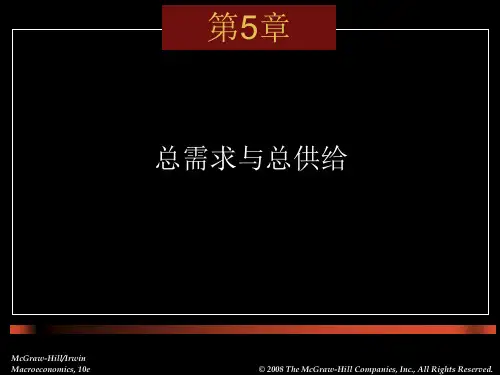
•
假定AD 增加至AD’:
•
•
•
总需求政策与古典供应曲线
•
总需求AD的增加引发的价格 上升 减少了实际货币存 M , 并引起支出的减 量, P 少
•
[Insert Figure 5-10 here]
经济将AD向上推进,直至价格 上升到足够高的水平, 实际货币 存量 M/P 降到足够低, 使支出减 少到与充分就业产量相一致的 水平 在E’’, 总需求在更高的 政府支出水平上 ,再次与总供 给相等 AD = AS
[Insert Figure 5-6 here]
•
•
•
如果产量高于潜在产量(Y>Y*), 价 格将会上升,在下一个阶段还会更 高 如果产量低于潜在产量(Y<Y*), 价 格将下降,在下一个阶段还会更低 价格将继续随时间上升或者下降直 至Y=Y*
•
如果明天的价格水平等于今天的价 格水平,产量等于潜在产量(忽略价 格期望)
5-25
供给学派经济学
•
尽管有前面的例子,供给方面的政策还是有用的
• •
只有供给方面的政策才能永久性的提高产出 需求方面的政策只在短期内有效
•
很多经济学者强烈支持供给方面的减税政策, 但同时 认为要削减政府支出
•
税收降低, 政府支出也相应减少,对赤字的效应可能是接近 中性的
第5章
总需求与总供给
• • • • Item Item Item Etc.
McGraw-Hill/Irwin Macroeconomics, 10e
© 2008 The McGraw-Hill Companies, Inc., All Rights Reserved. 5-1
Chapter_15 The Demand for Money(宏观经济学,多恩布什,第十版)
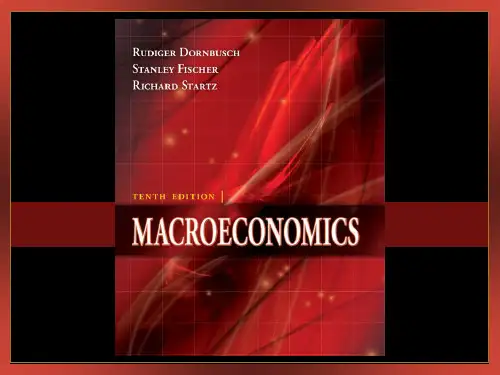
•
The more money a person holds, the less likely he or she is to incur the costs of illiquidity
•
The more money a person holds, the more interest he/she will give up → similar tradeoff encountered with transactions demand for money
4.
•
Standard of deferred payment
Money units are used in long term transactions (ex. loans)
15-5
The Demand for Money: Theory
•
The demand for money is the demand for real money balances → people hold money for its purchasing power
•
As liquidity of an asset decreases, the interest yield increases
•
A typical economic tradeoff: in order to get more liquidity, asset holders have to sacrifice yield
•
•
At the end of 2005, M1 = $4,596 per person Debate whether broader measure, M2, might better meet the definition of money in a modern payment system
2024年多恩布什宏观经济学课件
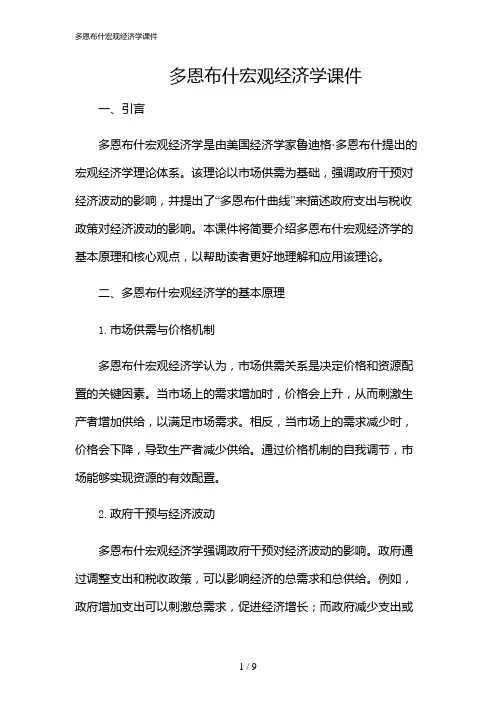
多恩布什宏观经济学课件一、引言多恩布什宏观经济学是由美国经济学家鲁迪格·多恩布什提出的宏观经济学理论体系。
该理论以市场供需为基础,强调政府干预对经济波动的影响,并提出了“多恩布什曲线”来描述政府支出与税收政策对经济波动的影响。
本课件将简要介绍多恩布什宏观经济学的基本原理和核心观点,以帮助读者更好地理解和应用该理论。
二、多恩布什宏观经济学的基本原理1.市场供需与价格机制多恩布什宏观经济学认为,市场供需关系是决定价格和资源配置的关键因素。
当市场上的需求增加时,价格会上升,从而刺激生产者增加供给,以满足市场需求。
相反,当市场上的需求减少时,价格会下降,导致生产者减少供给。
通过价格机制的自我调节,市场能够实现资源的有效配置。
2.政府干预与经济波动多恩布什宏观经济学强调政府干预对经济波动的影响。
政府通过调整支出和税收政策,可以影响经济的总需求和总供给。
例如,政府增加支出可以刺激总需求,促进经济增长;而政府减少支出或增加税收则会抑制总需求,导致经济放缓。
政府干预的目的在于通过调整总需求和总供给,实现经济的稳定和可持续发展。
三、多恩布什曲线多恩布什曲线是多恩布什宏观经济学中的重要概念,用于描述政府支出与税收政策对经济波动的影响。
多恩布什曲线是一条向下倾斜的曲线,表示政府支出与税收政策对总需求的影响程度。
1.政府支出增加当政府增加支出时,总需求会增加,导致多恩布什曲线向右移动。
这种政策可以刺激经济增长,提高就业水平,但也可能导致通货膨胀和财政赤字的增加。
2.税收减少当政府减少税收时,个人和企业的可支配收入增加,总需求也会增加,导致多恩布什曲线向右移动。
这种政策可以刺激消费和投资,促进经济增长,但也可能导致财政赤字的增加。
四、多恩布什宏观经济学在实践中的应用多恩布什宏观经济学在实践中有着广泛的应用。
政府可以通过调整支出和税收政策,来应对经济波动和实现经济目标。
1.经济增长与就业政府可以通过增加支出来刺激总需求,促进经济增长和就业。
宏观经济学多恩布什第十版ppt课件
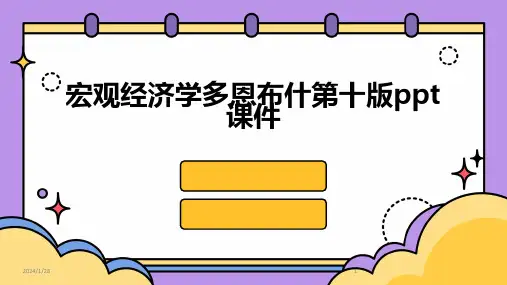
是从最终使用的角度反 映国内生产总值最终使 用去向的一种方法。最 终使用包括货物和服务 的最终消费、资本形成 总额和净出口三部分。
价格指数与通货膨胀率计算
价格指数
是反映不同时期一般价格水平的变化方向和变化程度的相对数。常见的价格指 数有消费物价指数(CPI)、批发物价指数(WPI)和GDP折算指数。
宏观经济学多课恩件布什第十版ppt
2024/1/28
1
contents
目录
2024/1/28
• 宏观经济学导论 • 国民收入核算与衡量 • 失业、通货膨胀与货币政策 • 长期经济增长与经济发展 • 总供给与总需求模型及其应用 • 国际经济关系与全球化进程中的挑战
2
01
宏观经济学导论
2024/1/28
技术进步是提高生产率和经济 增长的重要途径。通过加强科 技创新、促进科技成果转化、 培养高素质人才等方式,可以 推动技术进步和经济增长。
制度创新是经济增长的重要保 障。通过深化经济体制改革、 完善市场体系、加强法治建设 等方式,可以推动制度创新和 经济增长。
26
经济发展战略和政策选择
2024/1/28
长期经济增长与经济发展
2024/1/28
25
长期经济增长源泉和影响因素剖析
劳动力
资本积累
技术进步
制度创新
劳动力的数量和质量是影响长 期经济增长的重要因素之一。 随着人口红利的逐渐消失,提 高劳动力素质、促进劳动力流 动和优化配置将成为未来经济 增长的关键。
2024/1/28
资本积累是经济增长的重要源 泉。通过增加投资、提高投资 效率、促进资本市场发展等方 式,可以推动资本积累和经济 增长。
17
通货膨胀定义、类型及成因探讨
宏观经济学第十五章
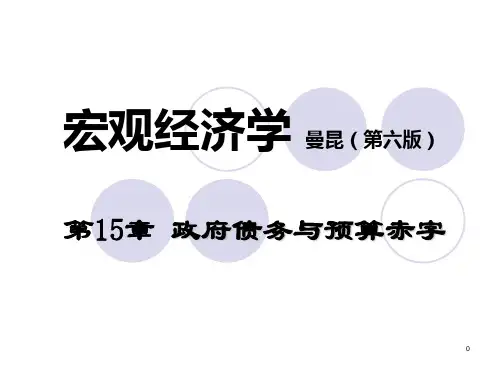
父母为什么要留遗产?
李嘉图等价的核心问题:不同代人之 间的联系;
父母为什么要为子女留下遗产:
利他主义; 控制子女,以不留遗产来威胁他们;
经验证据:父母越富有,子女回家次 数越多;而且,只有可以作为遗产留 下的财富才能导致更经常的回家探望 父母。
结论:不仅仅是“利他主义”。
27
15.3.3 政府债务的其它观点
1. 平衡预算与最优财政政策
一些政治家提议修改美国宪法,要求平衡每年 的联邦政府预算。
许多经济学家反对这个建议,认为赤字可以用 于:
稳定产出与就业 在收入波动时,平稳化税收 在适当的时机实现代际收入的再分配
28
政府债务的其它观点
2. 对货币政策的影响
• 政府赤字可以通过发行货币弥补 • 高额的政府赤字鼓励决策者创造通货膨胀 (以损害
据李嘉图等价定理,举 债弥补税收的减少不会 影响消费、国民储蓄、 实际利率、投资、净出 口或者实际GDP,即使 是在短期内。
22
李嘉图等价定理的逻辑
消费者是向前看的,今天减税形成的债务 意味着未来税收的增加(将来增加的税收 的现值等于今天减少的税收)。
减税不会使消费者变富,因此他们不会增 加消费。
1. 通货膨胀 2. 资本资产 3. 未计算的负债 4. 经济周期
12
衡量问题 1:
通货膨胀
为了理解通货膨胀何以成为问题,假定实 际债务不变,这意味着零实际赤字。
在此情况下,名义债务按通货膨胀率增加:
D/D = or D = D
报告期的(名义)赤字为 D,即使实际赤字
为零。
因此,为校正通货膨胀,必须从报告期赤 字中减去 D 。
二战 一战
冷战 反恐战
5
多恩布什《宏观经济学》复习资料(投资支出)【圣才出品】
第15章投资支出一、名词解释1.存货投资[中央财经大学2005研复试]答:存货投资指产量超过实际销售量时发生的存货积累,以及为保持生产连续性而准备的各种原材料等。
存货投资分为合意的存货投资和非合意的存货投资。
为确保生产顺利进行所持有的最低限度的原材料,为保证产品供应的连续性而持有的合适的产品,都属于合意的存货投资的范畴。
合意的存货水平可以用存货-销售比率来衡量,与产品生产速度、定货到来的快慢成正比,与利率水平成反比,与销售水平和社会需求的不确定性成正比。
如果实际存货超过了合意存货,超过的部分便被称为非合意存货。
存货投资往往无法预料,它在产量和不确定的销售量之间起缓冲的作用。
存货投资水平的变动与经济周期有关,二战以来的历次经济衰退被认为是公司存货普遍减少的结果。
2.资本存量调整的可变加速模型[中山大学2007研]答:资本存量调整的可变加速模型是投资理论中的一种,其基本观点是现有资本存量与合意资本存量之间的差距越大,企业投资速度就越快。
根据可变加速模型,企业在每一时期都打算填补合意资本存量与实际资本存量之间λ部分的差距,以便使当前时期结束时的实际资本存量K成为K0=K-1+λ(K*-K-1),其中上期结束时的资本存量表示为K-1,合意资本存量与实际资本存量之间的差距为(K*-K-1),资本存量调整速度为λ。
根据上述方程,净投资逐渐调整的表达式为:I=K0-K-1=λ(K*-K-1)。
上述净投资公式表明,当前投资支出取决于合意资本存量K*与上期实际资本存量K-1两者之差,二者之间的差额越大,企业投资速度越快。
3.投资的托宾q值[中央财经大学2016研;对外经济贸易大学2018研]答:投资的托宾q值是股票市场对企业资产相对于生产这些资产的成本进行的价值估算,q的最简单形式是企业的市场价值与资本重置成本之比。
当q>1时,即企业资产的市场价值大于企业资产的重置成本时,企业就有扩张的愿望,企业就应该增加实物资本。
多恩布什宏观经济学第十版原版
可持续发展与经济
增长
在追求经济增长的同时,应注重 环境保护和社会公平,实现可持 续发展。
03
失业、通货膨胀与货币政策
失业类型、原因及影响
摩擦性失业
由于劳动力市场供需不匹配导致的短 期失业。
结构性失业
由于经济结构变化或技术进步导致的 长期失业。
失业类型、原因及影响
• 周期性失业:由于经济周期波动导致的失 业。
经济增长是经济发展的基础,但经济发展还包括 结构优化、社会进步和生态改善等方面。
经济增长因素与政策建议
经济增长因素
包括资本积累、劳动力投入、技 术进步和制度变迁等,对经济增 长具有重要影响。
政策建议
针对经济增长因素,提出相应的 政策建议,如促进资本形成、提 高劳动力素质、推动技术创新和 深化制度改革等。
汇率政策选择
汇率政策是开放经济条件下 宏观经济政策的重要组成部 分。政府可以通过干预外汇 市场、调整汇率制度等方式 来影响国际贸易和资本流动 。
国际合作与政策 协调
在开放经济中,各国之间的 经济政策相互影响,因此国 际合作和政策协调变得尤为 重要。通过国际合作,各国 可以共同应对国际经济波动 和金融危机等挑战,促进全 球经济的稳定和繁荣。
总需求曲线形状及影响因素
总需求曲线形状
总需求曲线通常呈现向下倾斜的形状 ,表示随着价格的上升,消费者和投 资者的需求会减少。
01
02
消费者支出
消费者信心、收入水平和预期等因素 会影响消费者支出和总需求。
03
投资支出
企业盈利、利率和预期等因素会影响 投资支出和总需求。
净出口
国际贸易状况和汇率等因素会影响净 出口和总需求。
研究对象
多恩布什宏观经济学绪论
流动偏好 利息率 (货币需求数量) 货币供给数量 预期收益 资本边际效率 重置成本
B.凯恩斯主义理论的形成:
• 凯恩斯的追随者对凯恩斯经济学的补充和发展, 主要有以下几方面:
a.希克斯—汉森提出“IS-LM”模型,着重解决收 入变动影响货币需求从而也决定利率,而利率 又影响投资从而影响收入,将商品市场和货币 市场联系起来分析; b.汉森—萨缪尔森的“加速原理”,阐述收入增 加会通过消费影响投资,使引致投资增加,从 而有利于国民收入增加;
• 微观经济学与宏观经济学是互相补充的。
• 两者都采用了实证分析法,属于实证经济学。
• 两者都以市场经济制度为背景,都是市场经济 的经济学。
• 微观经济学是宏观经济学的基础。但总体经济 行为不是个体经济行为的简单加总。
5
宏观基本概念
• 增长和GDP
– 资源数量的变动;生产要素的效率变动
• 经济周期与产出缺口
B.凯恩斯主义理论的形成:
c.哈罗德—多马的经济增长模型:分析在生产技术 不变、资本-劳动比例不变条件下的经济增长问题; d.索洛的新古典经济增长模型:资本—劳动比例可 变条件下的经济增长问题; e.各种消费理论:凯恩斯的消费理论是现期收入、 绝对收入和实际收入为函数条件的;发展的消费 理论包括:杜生贝利的相对收入理论、弗里德曼 的持久收入假说和莫迪利安尼的生命周期假说; f.罗宾逊等提出的开放型经济模型。
• 私人支出不足导致萧条和高失业 • 短期问题
3
宏观经济学和微观经济学(区别)
研究对象 解决问题 中心理论 研究方法
微观经 个体经济活动者 资源最优配 济学 的行为及后果 置
价格理论
个量分析法
宏观经 社会总体经济行 资源充分利 国民收入决 总量分析法 济学 为及其后果 用 定论
宏观经济学多恩布什ppt课件
货币政策和财政政策在工具选择和运用上 应相互补充,形成合力,避免政策冲突和 抵消效应。
时机选择协调性
信息沟通与协作机制建立
货币政策和财政政策在应对经济波动时应 把握好政策出台的时机和力度,确保政策 效果最大化并减少副作用。
加强货币政策和财政政策制定部门之间的 信息沟通与协作,建立定期会晤机制和联 合行动框架,提高政策协调性和有效性。
GDP核算方法
包括生产法、收入法和支出法 三种。
收入法
GDP=劳动者报酬+生产税净 额+固定资产折旧+营业盈余 。
GDP定义
指一个国家或地区所有常住单 位在一定时期内生产活动的最 终成果。
生产法
GDP=各部门的总产出-各部门 的中间消耗。
支出法
GDP=最终消费支出+资本形 成总额+货物和服务净出口。
05 货币政策与财政 政策
货币政策工具、传导机制及效果评估
公开市场操作
通过买卖政府债券等方式调节市场流动性。
存款准备金率
调整商业银行存款准备金率以影响信贷规模 。
货币政策工具、传导机制及效果评估
• 利率政策:调整存贷款基准利率以引导市场利率 变动。
货币政策工具、传导机制及效果评估
利率渠道
通过影响市场利率进而影响投资和消费。
宏观经济学多恩布什ppt课 件
contents
目录
• 宏观经济学概述 • 国民收入核算与衡量 • 失业、通货膨胀与经济增长 • 总供给与总需求模型 • 货币政策与财政政策 • 开放经济下宏观经济政策选择
01 宏观经济学概述
宏观经济学定义与研究对象
宏观经济学定义
宏观经济学是研究整个经济体系 的总体经济行为、经济表现及其 变化规律的科学。
- 1、下载文档前请自行甄别文档内容的完整性,平台不提供额外的编辑、内容补充、找答案等附加服务。
- 2、"仅部分预览"的文档,不可在线预览部分如存在完整性等问题,可反馈申请退款(可完整预览的文档不适用该条件!)。
- 3、如文档侵犯您的权益,请联系客服反馈,我们会尽快为您处理(人工客服工作时间:9:00-18:30)。
• As liquidity of an asset decreases, the interest yield increases
1. Medium of exchange
• Money is used to pay for goods and services • Eliminates the need for a “double coincidence of wants”
2. Store of value
• An asset that maintains value • If money were not a store of value, it would not be used as a
Transaction and precautionary motives → mainly discussing M1 Speculative motive → M2, as well as non-money assets
15-7
Transaction Demand
• The transaction demand for money arises from the lack of synchronization of receipts and disbursements
15-5
The Demand for Money: Theory
• The demand for money is the demand for real money balances → people hold money for its purchasing power
• Two implications:
1. Real money demand is unchanged when the price level increases, and all real variables, such as the interest rate, real income, and real wealth, remain unchanged
• A typical economic tradeoff: in order to get more liquidity, asset holders have to sacrifice yield
15-4
The Functions of Money
• There are four traditional functions of money:
15-1
Components of the Money Stock
• In the U.S. there are two main monetary aggregates: M1 and M2
➢ M1 comprises those claims that can be used directly, instantly, and without restrictions → LIQUID
• You are not likely to get paid at the exact moment you need to make a payment → keep money on hand to make purchases between pay periods
• There is a tradeoff between the amount of interest an individual forgoes by holding money and the costs of holding a small amount of money
• The precautionary motive, which is the demand for money to meet unforeseen contingencies
• The speculative motive, which arises from uncertainties about the money value of other assets that an individual can hold
15-6Байду номын сангаас
The Demand for Money: Theory
• The theories covered here correspond to Keynes’s famous three motives for holding money:
• The transactions motive, which is the demand for money arising from the use of money in making regular payments
2. Equivalently, nominal money demand increases in proportion to the increase in the price level, given the real variables just specified
An individual is free from money illusion if a change in the level of prices, holding all real variables constant, leaves the person’s real behavior, including real money demand, unchanged.
medium of exchange
3. Unit of account
• The unit in which prices are quoted
4. Standard of deferred payment
• Money units are used in long term transactions (ex. loans)
